Expert Interviews
- University Reviews
- Career Guide
 Video Counseling
Video CounselingImportant Facts
- Ask any Question - CV Forum

What Are the 7ps of Marketing?
College Vidya Team Oct 11, 2024 11K Reads

Marketing is a critical component of any business's success, and it involves a range of strategies and techniques to promote products and services to potential customers. The 7Ps of marketing is a well-known framework that can assist companies in creating thorough marketing plans that cover all crucial facets of marketing. Product, pricing, promotion, place, people, process, and physical evidence are the 7 Ps of marketing.
Each of these components is essential to a marketing campaign's success, and knowing how to optimize each can help companies create marketing strategies that appeal to their target market. Each of the 7 Ps will be thoroughly discussed in this blog, along with how businesses can utilize each one to develop effective marketing strategies.
What are the 7 Ps of Marketing?
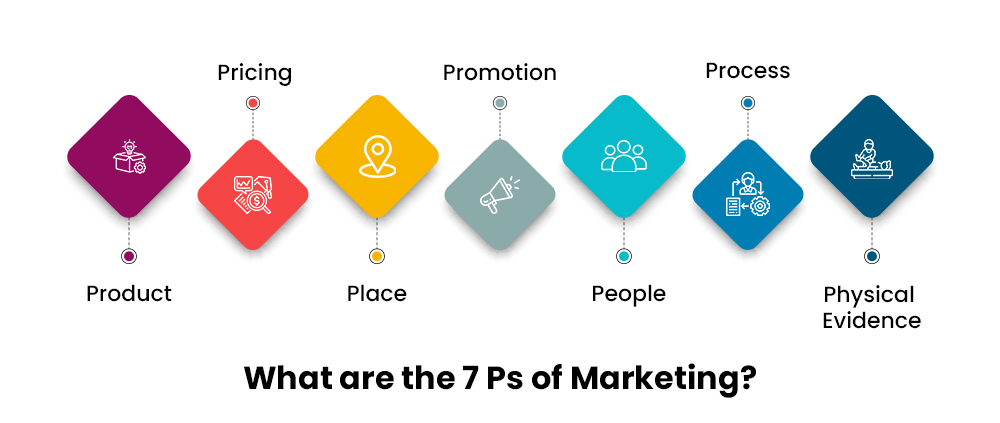
The 7Ps of marketing commonly referred to as the marketing mix, serve as a key foundation for companies to develop and carry out their marketing strategy. The 7Ps, which are interconnected and essential for establishing marketing success, are product, pricing, place, promotion, people, process, and physical evidence.
Video Source: Leaders Talk
Earlier there were only the 4 Ps of marketing that were introduced by Jerome McCarthy these are: Product, Price, Place, and Promotion. Later on, 3 additional Ps are added to this list that is: People, Packaging, and Process. And all these are now known as the 7 Ps of marketing.
Businesses can develop a thorough strategy that successfully satisfies the demands and desires of their target audience by comprehending and optimizing each of these components. Also, by continuously assessing and revising their marketing plans, organizations may remain ahead of shifting market dynamics and client demands, assuring long-term success and growth.
|
You May Interested in Some of the Online PG Courses |
|
A brief overview of the 7Ps of Marketing
The 7Ps stand for product, price, place, promotion, people, process, and physical evidence.
- Product refers to the goods or services that a business offers to its customers.
- Price is the amount customers pay for the product or service, which must be competitive in the marketplace.
- Place refers to the channels through which the product is made available to customers.
- Promotion includes advertising, public relations, and other methods used to communicate with customers.
- People refer to the employees who provide customer service and other aspects of the customer experience.
- Process refers to the systems and procedures that businesses use to create and deliver their products or services.
- Finally, physical evidence includes the tangible aspects of the product or service, such as packaging and branding.
This is a brief understanding of what these 7 Ps of marketing are, now let's gain a deep understanding of each one of the 7 Ps of marketing.
1) Product - 1st of 7P’s of Marketing
A product is a tangible or intangible good that is offered to fulfill a customer's need or desire. It is the basis of every marketing plan and has the power to create or ruin a business. A thorough understanding of the demands and preferences of the target market is necessary for the development of a successful product.
It is important to dedicate a lot of time and money to product development and oversight since the success of a company's product can have a substantial impact on its overall performance.
Importance of product in marketing
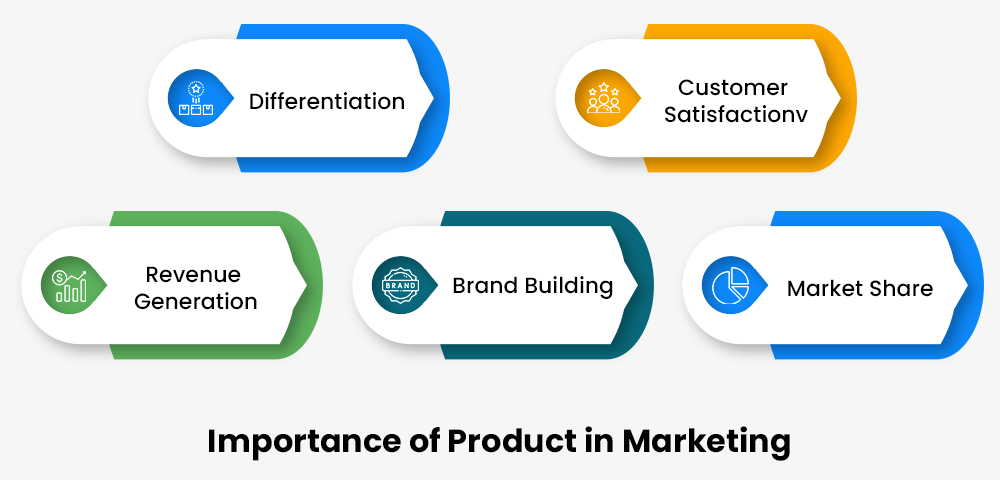
Each marketing strategy must start with the product, and its significance cannot be overstated. A successful product can be the key to a company's success, while a poor product can lead to failure. Here are a few reasons why the product is so important in marketing:
- Differentiation: A business can differentiate itself from its competitors and attract customers looking for something different by developing a unique and innovative product.
- Customer Satisfaction: A good product is designed to meet the needs and wants of customers. This leads to customer satisfaction, which is critical for building customer loyalty and repeat business.
- Revenue Generation: A successful product can generate significant revenue for a company. By creating a product that is in high demand, a company can increase sales and profits.
- Brand Building: A well-designed and well-marketed product can help to build a company's brand. The product becomes associated with the company's values and reputation, which can lead to increased brand awareness and loyalty.
- Market Share: A successful product can help a company to gain market share. By creating a product that is better than the competition, a company can attract customers away from its competitors and gain a larger share of the market.
Product life cycle

An illustration of the steps a product goes through from its introduction to its eventual decline is provided by the product life cycle. The four stages of the product life cycle are as follows:
- Introduction Stage: This is the phase where the product is initially made available on the market. Sales are often modest at this point, and the emphasis is on raising awareness and generating interest among prospective customers.
- Growth Stage: Sales at this point start to rise quickly as the product becomes more popular. Increasing brand recognition and broadening distribution channels are the main objectives at this stage.
- Maturity Stage: During this stage, sales growth begins to slow down as the market becomes saturated. Competition increases and companies focus on differentiating their products and maintaining market share.
- Decline Stage: In this final stage, sales begin to decline as the product loses its appeal to customers. Companies may choose to discontinue the product or reposition it in the market to try to extend its life cycle.
By understanding the stage of the product life cycle, companies can tailor their marketing efforts to the needs of the market and maximize the product's potential profitability.
2) Price - 2nd of 7P’s of Marketing
The second P which is the "price" refers to the economic value that customers are ready to pay for a good or service. Pricing decisions are important in the marketing strategy as they can have a significant impact on a company's profitability, market share, and overall success.
Considerations like the product's perceived value, the cost of manufacturing, the level of competition, and consumer demand must be carefully taken into account when determining the appropriate pricing.
Importance of price in marketing
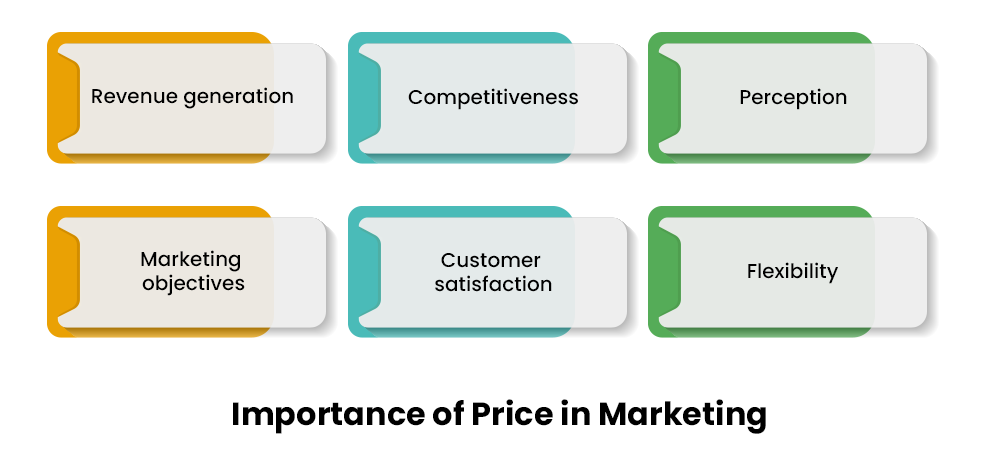
Price is a critical element in marketing strategy and plays a vital role in determining the success or failure of a product or service. Here are some of the reasons why the price is important in marketing:
- Revenue generation: Price is the primary driver of revenue for any business. Setting the right price for a product or service can help generate significant revenue and increase profits.
- Competitiveness: Price plays a crucial role in determining a company's competitiveness in the market. It can make a product more attractive or less attractive to customers compared to similar products offered by competitors.
- Perception: Price can create a perception of value in the minds of consumers. Customers may associate a higher price with higher quality or a premium product, while a lower price may be associated with lower quality.
- Marketing objectives: Price can be used to achieve various marketing objectives, such as increasing market share, penetrating new markets, or building brand image.
- Customer satisfaction: Pricing strategies can impact customer satisfaction. Setting a fair price that customers perceive as reasonable and providing value for money can help create customer loyalty and repeat business.
- Flexibility: Price is a flexible marketing tool that can be adjusted to respond to changing market conditions, customer preferences, and business objectives.
Overall, pricing is a crucial aspect of marketing that requires careful consideration and planning to achieve business goals and customer satisfaction.
Pricing strategies
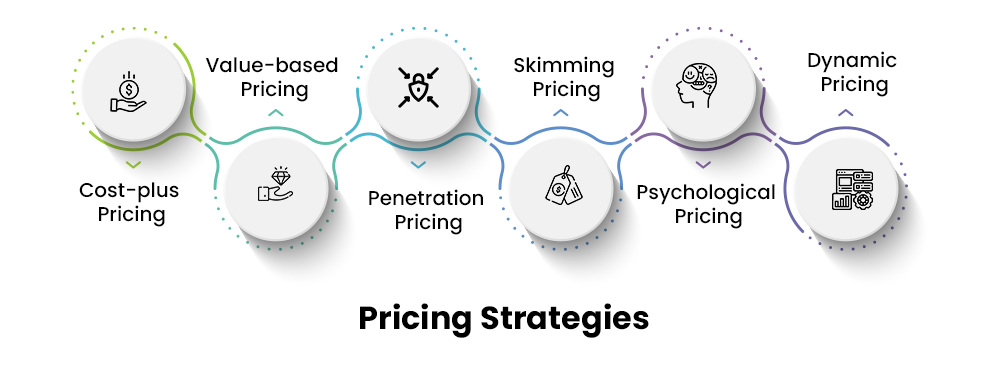
Pricing is an essential component of any marketing strategy, and there are several pricing strategies that a company can employ to maximize profitability and achieve its business objectives.
- Cost-plus pricing: This involves setting a price by adding a markup to the cost of producing the product. This approach is straightforward but can lead to pricing that is too high or too low if the cost estimates are inaccurate.
- Value-based pricing: This approach sets the price based on the value the product provides to the customer. Companies using this approach must understand their customer's willingness to pay and create products that deliver value that exceeds the price.
- Penetration pricing: This involves setting a low price initially to enter a new market and gain market share quickly. The objective is to attract price-sensitive customers who may switch from competitors due to the lower price.
- Skimming pricing: This approach sets a high price initially to target early adopters and those willing to pay a premium for a new or innovative product. As competition increases, the price is gradually lowered to attract price-sensitive customers.
- Psychological pricing: This approach uses pricing techniques to influence customers' perceptions of value, such as setting prices just below a whole number, which makes them appear lower.
- Dynamic pricing: This involves adjusting prices in real-time based on factors such as supply and demand, competition, and customer behavior. This approach is commonly used in industries such as travel and hospitality.
Choosing the right pricing strategy is critical to a company's success, and the choice should consider the product, competition, and target market. Companies must also be flexible and adapt pricing strategies as market conditions change.
|
You May Interested in Some of the Online UG Courses |
|
3) Place - 3rd of 7P’s of Marketing
Now comes the third P of marketing which refers to "Place," and is also known as distribution. Place refers to the strategies and tactics used by businesses to ensure that their products or services are available to customers at the right time and in the right place. Place involves determining how and where products or services will be produced, stored, transported, and sold to customers.
Importance of place in marketing
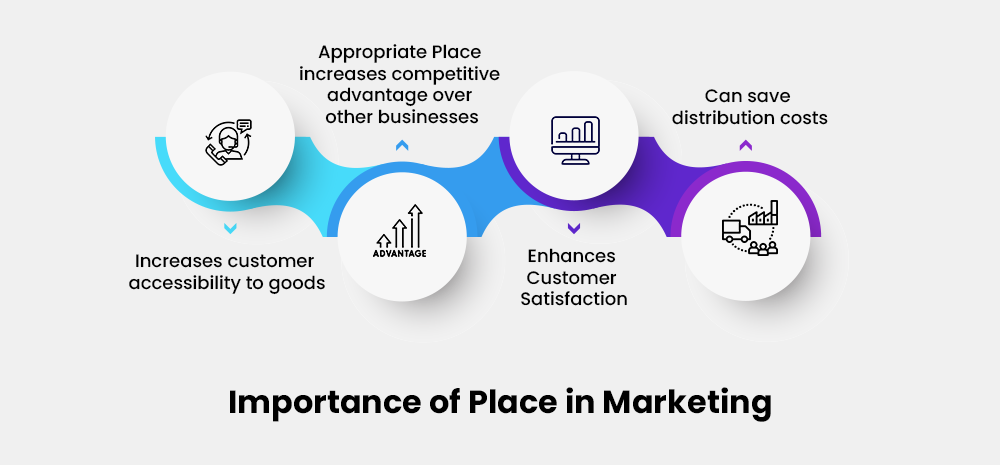
The importance of place in marketing can be highlighted in the following ways:
- Accessibility: Having goods or services available at the appropriate location enables customers to use them. When a product is offered where consumers like to shop, they are more inclined to buy it.
- Competitive Advantage: A business may have a competitive advantage as a result of its distribution strategy. A business has a competitive edge if it can supply goods or services more quickly, effectively, and conveniently than its competitors.
- Customer Satisfaction: Place affects customer satisfaction because it is a key factor in providing a positive shopping experience. Customers are more likely to be satisfied when they can easily find and purchase the products they need.
- Cost-Effective: Place is also important in terms of cost-effectiveness. By selecting the most efficient distribution channels and methods, companies can save money on distribution costs and offer products at lower prices.
In conclusion, it is impossible to overstate the significance of place in marketing. To make sure that their goods and services are widely available, and affordable, and provide customers with a satisfying shopping experience, businesses need to carefully plan their distribution strategy.
Types of distribution channels

There are several types of distribution channels that businesses can use to get their products or services to customers:
- Direct distribution: This is when a business sells its products or services directly to customers without any intermediaries. Examples of direct distribution channels include company-owned stores, websites, and sales representatives.
- Indirect distribution: This is when a business uses intermediaries to sell its products or services to customers. Examples of indirect distribution channels include wholesalers, retailers, and agents.
- Dual distribution: This is when a business uses both direct and indirect distribution channels to sell its products or services. For example, a company may sell its products through its website and also through retailers.
- Intensive distribution: This is when a business uses as many distribution channels as possible to reach a wide audience. This is commonly used for fast-moving consumer goods such as snacks, beverages, and toiletries.
- Selective distribution: This is when a business selects a limited number of intermediaries to sell its products or services. This is commonly used for products that require a certain level of expertise or service, such as high-end electronics or luxury goods.
- Exclusive distribution: This is when a business selects only one intermediary in a particular geographic area to sell its products or services. This is commonly used for luxury goods or products with a niche audience.
4) Promotion - 4th of 7P’s of Marketing
Promotion is one of the 7 Ps of marketing, and it refers to the communication techniques used to market or advertise a good or service to the intended audience. Promotion includes acts that encourage potential customers to purchase by raising awareness of, generating interest in, and increasing interest in the product or service. This comprises direct marketing, personal selling, public relations, and sales promotions.
Importance of promotion in marketing
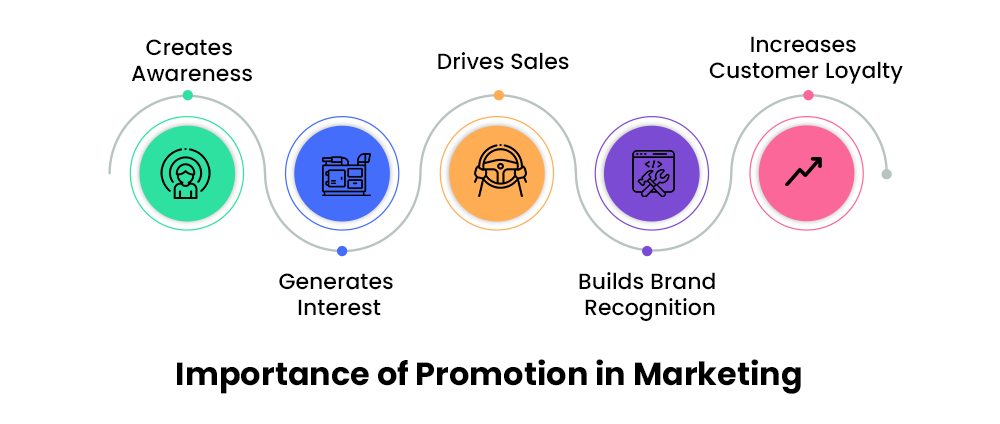
Here are some key reasons why promotion is important in marketing:
- Creates awareness: Promotion helps create awareness of a product or service among potential customers. Through various promotional activities like advertising, social media marketing, and public relations, businesses can reach out to their target audience and inform them about their products or services.
- Generates interest: Effective promotion can generate interest in a product or service among potential customers. By highlighting the benefits and features of a product or service, businesses can pique the interest of potential customers and encourage them to learn more.
- Drives sales: Driving sales is the promotion's main objective. Businesses can encourage prospective customers to buy items or services by properly promoting them, which will increase revenue and profits.
- Builds brand recognition: Promotion helps businesses build brand recognition and establish their brand in the minds of potential customers. By consistently promoting their products or services using a specific brand voice and message, businesses can create a strong brand identity that resonates with their target audience.
- Increases customer loyalty: Effective promotion can help businesses improve customer loyalty by reinforcing the value of their products or services. By promoting their products or services in a way that resonates with their target audience, businesses can create a loyal customer base that continues to purchase from them over time.
The Promotion Mix
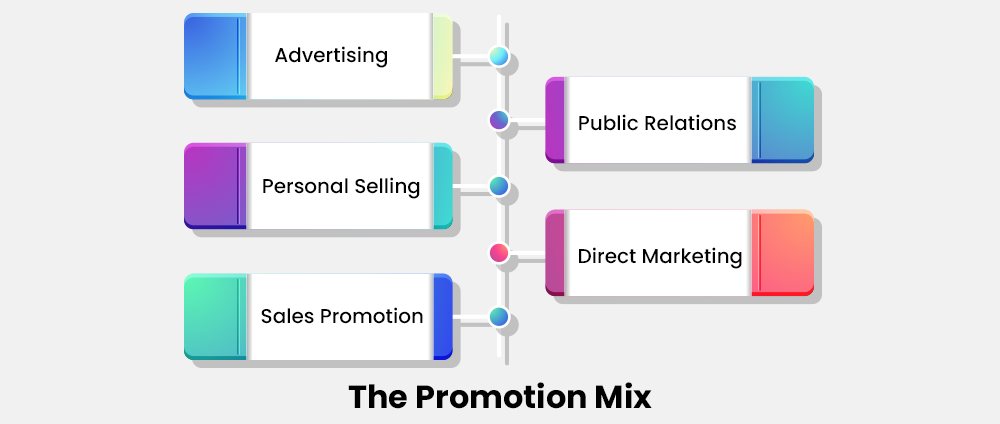
A company or organization employs a variety of different promotional tools and tactics known as the promotion mix, often referred to as the marketing communications mix, to advertise its goods and services to its target market. The promotion mix typically includes the following elements:
- Advertising: It is the practice of promoting a good, service, or brand using paid messaging or media. TV commercials, print ads, web ads, billboards, and sponsored content are a few examples of advertising.
- Personal selling: Personal selling entails direct interaction between a salesman and a prospective customer. Face-to-face conversations, phone calls, and online discussions are all examples of this.
- Sales promotion: Short-term incentives or discounts intended to entice customers to make a purchase are referred to as sales promotions. Coupons, free samples, and limited-time deals are a few examples of sales promotions.
- Public relations: Managing an organization's interaction with its audience, which includes consumers, investors, employees, and the media, is known as public relations. Press releases, media appearances, and crisis management are some examples of public relations activity.
- Direct marketing: Direct marketing entails contacting potential customers directly, frequently by telemarketing, direct mail, or email. Direct marketing, which frequently produces leads or sales, can be highly personalized and targeted.
|
You May Interested in some of the Popular Online MBA Specialization |
|
5) People - 5th of 7P’s of Marketing
In the realm of marketing, the 5th P, People, is often considered the most important. This is the term used to describe the target market that a business is attempting to reach and affect through its marketing initiatives. It is essential to comprehend the demands, wants, and behaviors of the consumers that make up a company's target market to create persuasive marketing techniques that appeal to them.
Companies can adjust their messaging, product offers, and customer service to better meet the requirements of their customers and build closer relationships with them by taking into consideration the traits and preferences of their audience. The people component of marketing is essential for creating lasting connections with customers and driving business success.
Importance of people in marketing
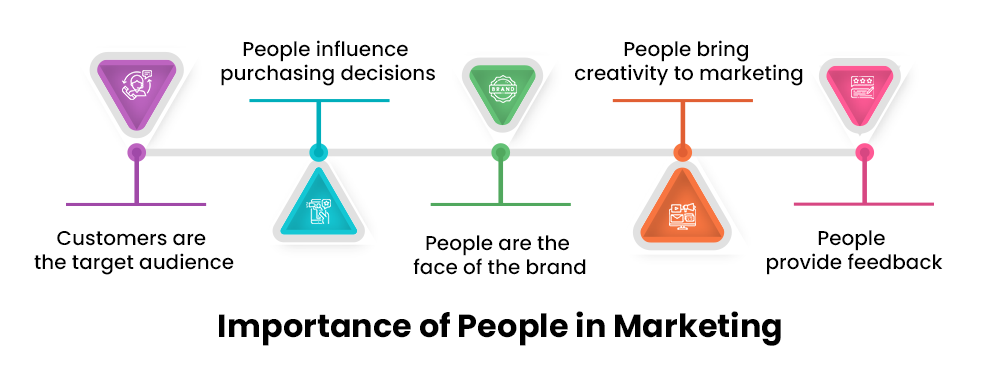
The importance of people in marketing cannot be overstated, as they play a critical role in the success of any marketing campaign. Here are some reasons why people are important in marketing:
- Customers are the target audience: Customers, the target market for the good or service being advertised, are at the center of each marketing strategy. Effective marketing strategies must take into account the needs, wants, and preferences of the target audience.
- People influence purchasing decisions: With suggestions from others, online reviews, and social media, people have a big impact on how other people make purchases. A marketing campaign's performance can be greatly influenced by rave reviews and referrals from pleased clients.
- People are the face of the brand: Whether it's the sales team, the customer service agents, or the brand ambassadors, people represent the brand. They reflect the company's brand and principles while interacting with customers directly.
- People bring creativity to marketing: People may help marketing efforts stand out from the competition by bringing creativity and new views to them. They are capable of developing original concepts, strong writing, and eye-catching graphics that draw in prospective customers.
- People provide feedback: Consumer input is essential for enhancing goods, services, and marketing initiatives. With focus groups, polls, and online reviews, people offer insightful input that businesses may use to make better decisions and improve their marketing tactics.
In conclusion, people play a vital role in marketing, as they are the target audience, influencers, brand ambassadors, creative minds, and sources of valuable feedback. Companies that prioritize people in their marketing strategies are more likely to succeed in the long run.
How people affect the customer experience
People play a crucial role in shaping the customer experience. From the first point of contact with a customer to the ongoing interactions, the behavior and actions of employees, vendors, and partners can either enhance or diminish the customer experience.
Here are a few ways in which people can affect the customer experience:
- Attitude and demeanor: The customer experience can be significantly impacted by the attitude and demeanor of employees. While a negative, apathetic, or dismissive approach can make consumers feel frustrated and disengaged, a pleasant, friendly, and helpful attitude can help customers feel valued and appreciated.
- Product knowledge and expertise: Consumers assume that staff members will be competent and able to address their inquiries about goods or services. Customers may become frustrated if staff members are unable to offer useful advice or guidance due to a lack of product knowledge or expertise.
- Communication skills: For businesses to provide satisfying client experiences, effective communication is essential. Building trust and trust with customers can be facilitated by staff members who can communicate, listen intently, and adapt to the communication style of the consumer.
- Timeliness and responsiveness: Consumers want their demands to be handled quickly and effectively. Customers may become irritated and unsatisfied with employees if they take a long time to answer their requests or if they break their commitments.
- Empathy and understanding: Customers want to feel understood and cared for. Employees who demonstrate empathy and understanding can help alleviate customer concerns and create a positive emotional connection.
6) Process - 6th of 7P’s of Marketing
In the context of marketing, process refers to the series of steps or activities that a company undertakes to provide its products or services to customers. From the first point of interaction with the consumer through the follow-up after the sale, it includes everything.
A well-designed marketing process can help a company deliver consistent, high-quality experiences to its customers, leading to greater customer satisfaction and loyalty. It can also improve efficiency and reduce costs by streamlining operations and eliminating redundancies.
A good marketing process should be customer-centric, agile, and adaptable to changing market conditions, ensuring that the company remains competitive and relevant in a fast-paced business environment.
Importance of process in marketing
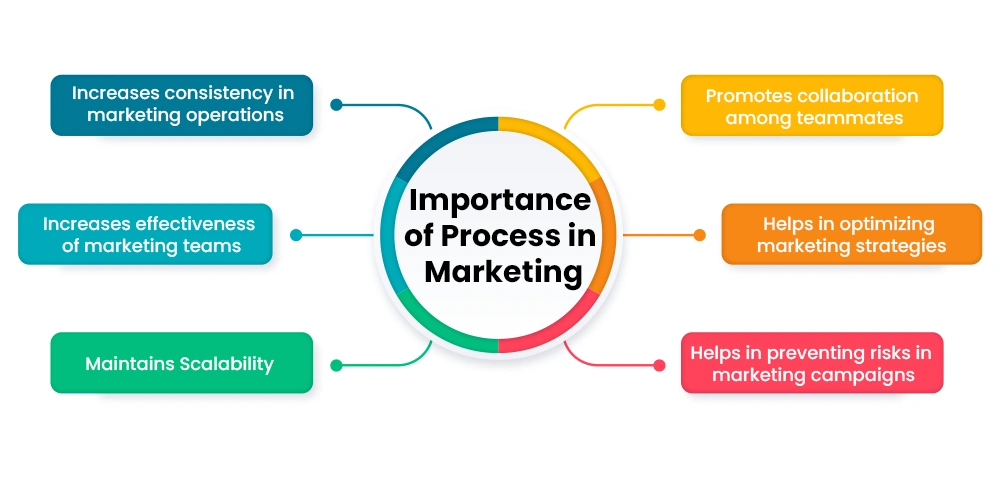
Process plays a crucial role in the success of any marketing initiative. Here are some points on the importance of process in marketing:
- Consistency: Consistency in marketing operations is ensured by the process. Marketing initiatives may be carried out consistently throughout time with a clearly defined process in place, which produces greater outcomes and a more recognizable brand.
- Efficiency: The effectiveness of marketing teams is aided by a clearly defined process. The team can reduce errors, conserve time and resources, and concentrate on getting results if there are clear instructions on what needs to be done and how to do it.
- Scalability: A process that aids in maintaining scalability as marketing initiatives expand in scope and complexity. It guarantees that the campaign can be readily repeated, changed, and expanded without lowering the standard of the campaign.
- Collaboration: Collaboration across many teams and departments is necessary for the marketing process. Each team member will be better able to grasp their responsibilities and roles, communicate more effectively, and collaborate as a unit with a well-defined process.
- Optimization: Through changes in the process one can continuously improve their marketing strategies. The marketing team may gradually improve the outcomes by examining the performance statistics and making the required adjustments to the process.
- Risk management: The process helps to mitigate risks in marketing campaigns. By identifying potential risks and establishing measures to prevent or address them, the marketing team can minimize the impact of negative outcomes.
Overall, a well-defined process is critical for effective marketing campaigns. It helps the team to work more efficiently, collaborate better, and achieve better results over time.
Types of processes involved in marketing
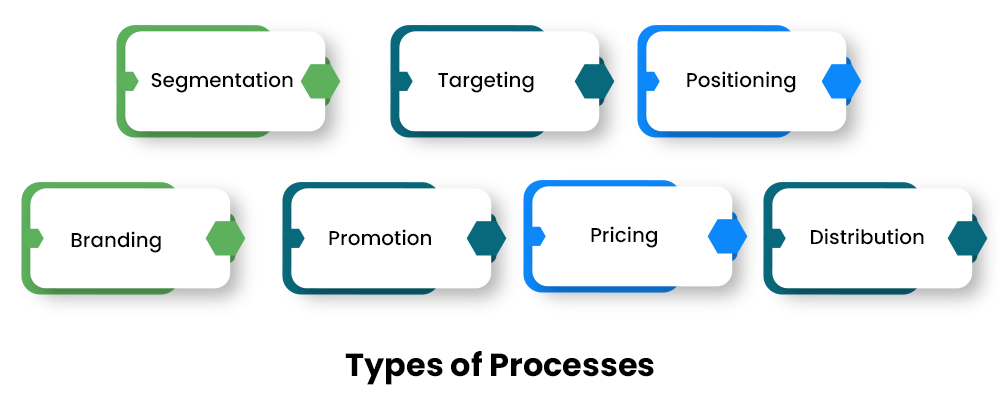
There are several types of processes involved in marketing strategies, including:
- Segmentation: The technique of separating a sizable market into more manageable segments based on shared demands, traits, or behaviors.
- Targeting: The process of deciding which niche markets to concentrate on, depending on their potential for profitability and compatibility with the company's objectives.
- Positioning: The process of giving a company's product or service a distinctive image and identity in the eyes of the target market.
- Branding: Developing a unique name, logo, or other attributes to distinguish a company's goods or services from those of its rivals is known as branding.
- Promotion: The process of reaching out to current and new customers through public relations, advertising, sales promotions, and personal selling.
- Pricing: The process of setting the price for a product or service that will maximize profits while also satisfying the target audience.
- Distribution: The process of making a product or service available to the target audience through various channels such as retailers, wholesalers, or direct sales.
Overall, these procedures are linked and should be coordinated to produce a marketing plan that is successful and serves the needs of both the company and its customers.
|
You May Interested In Online Diploma and Certificate Programs |
|
7) Physical evidence - 7th of 7P’s of Marketing
The seventh "P" of marketing, "Physical Evidence," stands for the material things that help buyers understand the value of a brand.
This might refer to a product's or store's appearance, the level of the materials used in packaging, or the layout of a website. Physical evidence can be extremely essential in influencing how customers view a business since it can serve to communicate crucial information about quality, dependability, and trustworthiness.
For organizations, having a strong physical presence is crucial for winning over customers' trust and establishing credibility. Companies may leave a lasting impression and distinguish out in a competitive marketplace by investing in superior physical evidence.
Importance of physical evidence in marketing

Physical evidence is an essential component of marketing that helps to create a positive perception of a brand, product, or service in the minds of customers. Here are some of the reasons why physical evidence is important in marketing:
- Builds Credibility: A brand or company's credibility can be proven physically by factors like product packaging, retail layout, and customer service standards. Customers will become more receptive to your brand as a result, increasing brand loyalty.
- Enhances Brand Perception: Physical evidence can create a powerful first impression that can influence customers' perception of a brand. For example, a well-designed website or a clean and attractive store can communicate professionalism and quality to customers, enhancing the brand's perception in their minds.
- Differentiates from Competitors: Physical evidence can help to differentiate a brand or business from its competitors. Unique product packaging or a distinctive store design can help a brand stand out from the competition and create a memorable experience for customers.
- Creates Emotional Connections: Physical evidence can create emotional connections with customers by appealing to their senses. For example, the aroma of freshly baked goods in a bakery or the luxurious feel of a high-end product can create positive emotional associations with a brand.
- Increases Sales: Effective use of physical evidence can increase sales by creating a positive buying experience for customers. This can lead to repeat business and positive word-of-mouth recommendations.
Overall, physical evidence plays a crucial role in marketing by providing tangible evidence of a brand's quality, creating emotional connections with customers, and differentiating a brand from its competitors.
Types of physical evidence

Several types of physical evidence can be used in marketing strategies, including:
- Packaging: The packaging of a product can be a key physical evidence element in marketing. It can express vital details about the product, such as its features and advantages, and it can also reflect the brand's character and image.
- Store design and layout: Customers may get a certain feeling and perception from a store's layout and design. The visual representation of a brand can be influenced by things like displays, lighting, and color.
- Point of sale materials: The usage of materials like banners, posters, and signage may help a brand reinforce its message and establish a unified visual identity across all of its touchpoints.
- Testimonials and reviews: Physical evidence of a brand's credibility and quality can be found in satisfied customer testimonials and reviews.
- Awards and certifications: Awards and certificates can show a brand's dedication to excellence and quality, offering concrete proof of its value proposition.
- Physical location: A business's physical location can convey a sense of distinction, exclusivity, or accessibility, making it a potent physical evidence element.
Overall, physical evidence plays an important role in marketing by providing tangible and credible evidence of a brand's value proposition, quality, and credibility.
|
Are you Familiar with Some Popular College Vidya’s Tool? |
|
Importance of understanding the 7 Ps of Marketing
Businesses that wish to create effective marketing strategies must have a solid understanding of the 7Ps of marketing.
Companies may establish a thorough marketing strategy that caters to the requirements and preferences of their target market by studying and optimizing each of the 7Ps. Let’s know the importance of understanding each one of the 7 Ps one by one.
- Product: To position their product effectively in the market and develop a product strategy that meets the target audience's needs, one must have a great understanding of their product’s unique features and benefits.
- Price: Choosing the right price is important for attracting both new businesses and retaining existing customers. One can choose the best pricing plan for their product by considering the pricing strategies of their competitors and the value that their product offers.
- Place: Making the product available to their target audience requires understanding where they are and how to reach them. One can more effectively connect with consumers if one knows which distribution channels to use, whether it be through stores, wholesalers, or internet sales.
- Promotion: Understanding how to effectively promote their product will help them reach their target market and increase sales. One may create a successful promotional plan by being aware of the many promotion channels accessible, such as advertising, sales promotions, and public relations.
- People: Customers' perceptions of a brand are significantly influenced by the people who represent it, whether they are employees or independent contractors. One may provide a better consumer experience by knowing how to hire, train, and inspire their personnel.
- Process: The method through which a product or service is delivered to the consumer has a significant role in the whole customer experience. One can provide a better customer experience by comprehending the many processes involved in the process and identifying areas for improvement.
- Physical Evidence: The brand's tangible expressions, such as its logo, packaging, and shop design, can greatly influence how buyers perceive the company. Building trust and loyalty with company customers can be facilitated by knowing how to create and offer a consistent visual brand identity.
By understanding and optimizing each of these 7Ps, businesses can create a strong, cohesive marketing plan that drives growth and success. Additionally, by continually monitoring and adapting their marketing strategies, businesses can stay ahead of changing market conditions and customer needs, ensuring long-term success.
| Trending Topics | |
Conclusion
In conclusion, the 7 Ps of marketing provide a comprehensive framework for businesses to develop effective marketing strategies. By considering all aspects of the marketing mix, including product, price, place, promotion, people, process, and physical evidence, businesses can create a strong brand identity, attract and retain customers, and ultimately achieve their business goals. While each of the 7 Ps is important, businesses should also understand that they are not static and should be continually evaluated and adjusted as market conditions change. By applying the 7 Ps of marketing, businesses can improve their marketing efforts, build stronger relationships with their customers, and ultimately achieve long-term success.
FAQs (Frequently Asked Questions)
The 7 Ps of marketing is a framework for marketing that includes Product, Price, Place, Promotion, People, Process, and Physical evidence.
The 7 Ps of marketing help businesses to create a comprehensive marketing strategy that considers all aspects of the marketing mix, which includes the product or service being offered, its pricing, where it will be sold, how it will be promoted, who the target customers are, how the sales process will be managed, and what physical evidence will be provided to customers.
Product refers to the actual goods or services that a company offers for sale. This includes design, features, packaging, and branding.
Price refers to the amount of money that a company charges for its products or services. This includes pricing strategies, discounts, and pricing structures.
Place refers to the location where a company sells its products or services. This includes distribution channels, logistics, and the physical locations where products are sold.
Promotion refers to the marketing activities that a company uses to communicate with its target audience. This includes advertising, sales promotion, personal selling, and public relations.
People refer to the employees and staff who work for a company. This includes training, recruitment, and customer service.
Process refers to the systems and procedures that a company uses to deliver its products or services to customers. This includes order processing, customer support, and service delivery.
Physical evidence refers to the tangible elements that a customer can see, touch, or experience when interacting with a company. This includes product packaging, store design, and website design.

Idea Alchemist / Concept Creator / Insight Generator
We are an online education platform where users can compare 100+ online universities on 30+ X-factors in just 2 minutes. With an active CV community, we have transformed online learning to quite an extent. With the CV Subsidy scheme, we contributing to GER in India while helping our learners with their finances in their “Chuno Apna Sahi” journey!
Every query is essential.
Our team of experts, or experienced individuals, will answer it within 24 hours.
Recommended for you
Tired of dealing with call centers!
Get a professional advisor for Career!
LIFETIME FREE
Rs.1499(Exclusive offer for today)

Pooja
MBA 7 yrs exp

Sarthak
M.Com 4 yrs exp

Kapil Gupta
MCA 5 yrs exp
or



Career Finder
(Career Suitability Test)
Explore and Find out your Most Suitable Career Path. Get Started with our Career Finder Tool Now!
ROI Calculator
Find out the expected salary, costs, and ROI of your chosen online university with our free calculator.

